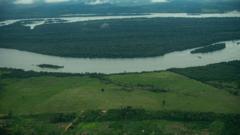Tomas Anez Dos Santos was working in a small clearing in the Peruvian Amazon when he heard footsteps approaching in the forest. He realized he was surrounded and froze. One was standing, aiming with an arrow, he says. And somehow he noticed I was here and I started to run.
He had come face to face with the Mashco Piro. For decades, Tomas, who lives in the small village of Nueva Oceania, had been practically a neighbor to these nomadic people, who shun contact with outsiders. However, until very recently, he had rarely seen them.
The Mashco Piro have chosen to be cut off from the world for more than a century, hunting with long bows and arrows, relying on the Amazonian rainforest for everything they need. They started circling and whistling, imitating animals, Tomas recalls. The villagers feel conflicted, fearing their arrows while respecting these distant "brothers" living in the forest.
A new report by Survival International states there are at least 196 uncontacted tribes left in the world, with the Mashco Piro being the largest. The report warns that half of these groups could be wiped out in a decade due to logging, mining, and disease. Tomas notes the noise from logging activity reaches his village, threatening the Mashco Piro's environment.
In Nueva Oceania, some locals report increasingly frequent encounters with the Mashco Piro, raising safety concerns. Yet, despite fear, there's a desire to protect the tribe's way of life. Tomas expresses, Let them live as they live; we can't change their culture.
Even as the Peruvian government enforces policies of non-contact with isolated peoples, illegal logging continues, and the Mashco Piro's territory is increasingly compromised. Volunteers like Tomas hope for greater government intervention to protect both the Mashco Piro and the villagers, feeling abandoned in their struggle for coexistence.
He had come face to face with the Mashco Piro. For decades, Tomas, who lives in the small village of Nueva Oceania, had been practically a neighbor to these nomadic people, who shun contact with outsiders. However, until very recently, he had rarely seen them.
The Mashco Piro have chosen to be cut off from the world for more than a century, hunting with long bows and arrows, relying on the Amazonian rainforest for everything they need. They started circling and whistling, imitating animals, Tomas recalls. The villagers feel conflicted, fearing their arrows while respecting these distant "brothers" living in the forest.
A new report by Survival International states there are at least 196 uncontacted tribes left in the world, with the Mashco Piro being the largest. The report warns that half of these groups could be wiped out in a decade due to logging, mining, and disease. Tomas notes the noise from logging activity reaches his village, threatening the Mashco Piro's environment.
In Nueva Oceania, some locals report increasingly frequent encounters with the Mashco Piro, raising safety concerns. Yet, despite fear, there's a desire to protect the tribe's way of life. Tomas expresses, Let them live as they live; we can't change their culture.
Even as the Peruvian government enforces policies of non-contact with isolated peoples, illegal logging continues, and the Mashco Piro's territory is increasingly compromised. Volunteers like Tomas hope for greater government intervention to protect both the Mashco Piro and the villagers, feeling abandoned in their struggle for coexistence.















